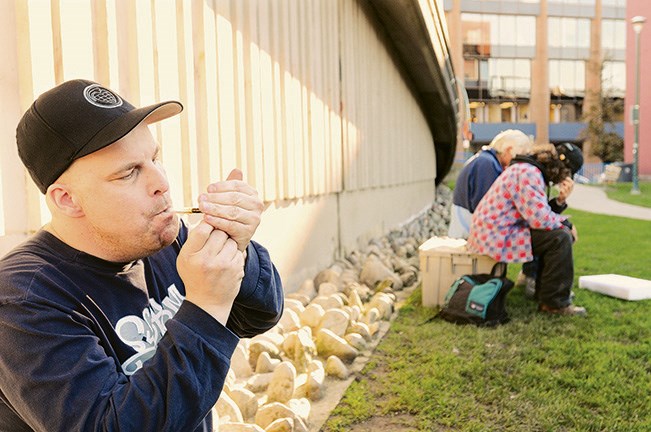The mass distribution of 65,000 crack cocaine smoking kits in the Downtown Eastside did not trigger more drug activity but reduced burns to crack smokers and decreased the reliance on used smoking equipment.
That’s the conclusion of Vancouver Coastal Health chief medical health officer Dr. Patricia Daly as she examined the results of a 13-month evaluation of 4,213 crack smokers.
“Their behaviour indicates that they’re involved in less high-risk behaviour and that might reduce some of their infection risks associated with crack smoking,” said Daly of the health agency’s evaluation released last week.
The project cost $118,000, with $43,000 spent on supplies, $35,000 on “peer support and education” and $25,000 on putting the kits together. An additional $15,000 was spent on the evaluation, which Vancouver Coastal Health did with the Centre for Addictions Research of B.C.
The evaluation period ran from December 2011 to November 2012 and had various organizations, including community health clinics and the Vancouver Area Network of Drug Users, assemble and distribute 65,299 sterile kits that included glass stems, pipe screens, mouthpieces and alcohol swabs.
The same kit providers, which included the PHS Community Services Society, made 721 referrals to health services and 1,280 to addiction services. The research also indicated crack smokers were educated about safe smoking practices to avoid cuts, burns and the sharing of pipes.
“These interactions suggest that harm reduction service providers are engaging with a group of people to provide education and referrals and addiction services who may not have received them in the past,” the study said.
“While there was no significant difference reported after the pilot in the proportion of survey respondents who accessed drug or alcohol treatment, the [evaluation] may not have been long enough to observe such differences.”
The participants in the evaluation were an average age of 42, predominantly aboriginal, unemployed, with 22 per cent having completed high school. Almost 50 per cent were living in a single-room occupancy hotel, hostel or boarding room.
The evaluation discovered that burns to the mouths of crack smokers dropped from 25 per cent to 15 per cent, and cuts from 18 per cent to 12 per cent.
Daly said the glass stems were key to the kits, noting there was a large outbreak of pneumococcal bacterial infection among crack users in 2006. Health officials believe the infection was related to unsanitary stems which can break and cause cuts to the lips and face.
A study published in October 2009 in the Canadian Medical Association Journal revealed a spike in HIV rates in the city’s crack smokers.
Study researchers tracked 1,048 crack users over a nine-year period and found that 137 became HIV positive. The reason for the increase was not definitive but researchers said it could be attributed to wounds produced around the mouth when smoking crack from a pipe.
Recommendations reached in the evaluation call for agencies to continue supplying sterile kits to crack smokers in the same way needle exchanges supply sterile needles and injection supplies to intravenous drug users.
But the report does not recommend what drug activists have requested for many years: a legal facility where crack smokers can smoke their drugs as injection drug users do at the Insite supervised injection site.
Daly said she supports a scientific research project to open such a facility. But, she said, neither the health agency nor a non-profit has applied to the federal government to set up the experiment.
The evaluation did not measure whether the supply of crack smoking kits had any effect on public disorder in the Downtown Eastside.
The Courier reported in February that the Vancouver Police Department recorded 1,018 fewer charges for cocaine from 2008 to 2012.
The dramatic drop went from 2,082 charges in 2008 to 1,064 in 2012. The most significant decrease in that five-year span occurred in 2011, with 970 charges recorded.
mhowell@vancourier.com
twitter.com/Howellings



